Malaria life cycle
Anti-malarial drugs: Mapalrial Parasites Life cycle
PHARMACOLOGY
Alok Bains
5/13/20234 min read


malarial parasites Life-cycle
Under Anti-malaria drugs
Compiled by: Alok Bains
Malaria is an endemic protozoal disease caused by four species of plasmodium causing malaria: Plasmodium vivax, Plasmodium falciparum, Plasmodium malareae and Plasmodium ovale. Plasmodium is transmitted through female anopheles mosquito bites. Malaria in humans caused by Plasmodium falciparum is the most dangerous that causes acute malaria with symptoms of high fever, postural hypotension and massive rapture of RBC. That produces redness and swelling in limbs. Malaria in humans caused by Plasmodium vivax is mild and most common malaria. Symptoms of malaria due to Plasmodium vivax are acute fever and chills, heavy sweating, liver and spleen enlargement, anaemia, headache lethargy, and abdominal cramps. Malaria by Plasmodium ovale is rarely found. Malaria by Plasmodium malareae is most common in tropical countries.
Life-cycle of malarial parasites
Malarial parasites (Plasmodium) have two hosts i.e. mosquito and human. Life-cycle of malarial parasites can be divided into two phases: The asexual phase in humans and the sexual phase in female anopheles mosquitoes.
Asexual Phase (In Humans):
The asexual phase of the plasmodium life cycle occurs in the human body. It has the following four stages: Pre-erythrocytic schizogony, Exoerythrocytic schizogony, Erythrocytic schizogony, Gametogony and latent stage.
Pre-erythrocytic schizogony or Primary Exo-erythrocytic schizogony: Sporozoites enter into human blood during an infected anopheles mosquito bite. These sporozoites enter into human liver cells. Here it grows to form schizont. Schizont divides to form cryptozoite. This division is called schizogony. Infected liver cells rapture to release cryptozoites into space inside the liver space having blood. Pre-erythrocytic schizogony last for 8 days for Plasmodium vivax, 6 days for Plasmodium falciparum and 9 days for Plasmodium ovale.
Exoerythrocytic schizogony: Cryptozoites (merozoites) from pre-erythrocytic phase enter into other liver cells. Here they multiply to form metacryptozoites. Cells rapture to release metacryptozoites. Smaller metacryptozoites (micrometacryptozoites) enter into blood while larger metacryptozoites (macrometacryptozoites) re-enter into other cells of the liver.
These two stages do not show any clinical symptoms. Inoculation of this blood does not show any infection.
Erythrocytic schizogony: Micrometacryptocytes (micromerozoites) enter into RBC (erythrocyte) from blood plasma. Parasites inside RBC undergoes the following changes:
Young trophozoites and Signet ring stage: Inside RBC, micrometacryptozoites become round to form trophozoites. A large central vacuole appears inside the trophozoite as it grows. This vacuole pushes the cytoplasm and nucleus of a trophozoite to form a signet ring-like structure in trophozoites.
Amoeboid stage: Trophozoites become amoeboid in shape and vacuoles disappear. They also secrete digestive enzymes that digest the cytoplasm of erythrocytes. They live on haemoglobin of RBC. These trophozoites are also called erythrocytic schizonts.
Eythrocytic Micrometacryptocytes (Merozoites): RBC rapture to release these erythrocytic merozoites. These released erythrocytic merozoites attack other RBCs. During this release fever appears in infected humans.
The blood smear shows the presence of parasites after 3 to 4 days from the date of completion of pre-erythrocytic schizogony. Entry of sporozoites into human blood and appearance of erythrocytic schizonts in blood takes 14 days in Plasmodium vivax and Plasmodium ovale infection, 12 days in Plasmodium falciparum and 28 days in Plasmodium malariae. This period is called incubation period for the malaria parasite.
Gametogony: The formation of gametocytes from erythrocytic merozoites is called gametogony. During erythrocytic schizogony, some merozoites enter into fresh RBC while others form gametocytes. These are sexual forms of the Plasmodium parasite. Female gametocytes are large in shape called macrogametocytes while male gametocytes are smaller in shape called microgametocytes. It takes four days to form gametocytes from erythrocytic schizonts.
Sexual phase (In Female Anopheles Mosquito):
Female anopheles mosquitoes are the definitive phase (Primary host) for the malaria parasite. Female anopheles mosquitoes live on human blood. The malaria parasite does not harm mosquitoes.
The sexual phase of plasmodium parasites (Maaria parasites) starts inside the human body by the formation of male gametocytes (microgametocytes) and female gametocytes (macrogametocytes). During blood-sucking from infected humans by female anopheles mosquitoes, gametocytes (Sexual form of parasites), as well as asexual forms of parasites enter into the mosquito midgut. Here asexual forms of plasmodium do not survive but development in gametocytes occurs. It has been observed that female anopheles mosquitoes having a number of female gametocytes higher than male gametocytes are capable of infecting healthy humans. If a number of female gametocytes is less than male gametocytes then female anopheles mosquitoes shall not be able to infect healthy humans.
One male gametocyte (microgametocyte) develops 4 to 8 thread-like filamentous structures inside the mosquito gut. This filamentous microgametocyte is called a microgamete. The formation of thread-like filaments is called ex-flagellation. There will be no flagellation in female gametocytes (macro-gamete). Development in macro-gametocyte occurs to form macrogamete. One macro gametocyte forms only one macrogamete. One male gamete (microgametocyte) fuses with the periphery of one female gamete (macrogamete) to form a zygote. Development of zygote from gametocytes requires 20 minutes to 120 minutes.
The length of zygotes increases and the mature zygote is called an ookinete. It takes 24 hours to form ookinetes. Oookinetes develop to form oocysts. Oocyst is a spherical mass covered by a capsule. Oocyte contains the single vesicular nucleus and pigment granules of macrogamete. Oocyte size increases and from mature oocyte that undergoes meiotic and mitotic cell division to form large sporozoite. These developments in oocytes occur in the mosquito's stomach. Fully mature oocyte rapture to release sporozoites into the body cavity of mosquito. Sporozoites enter into several tissues of mosquitoes. The maximum number of sporozoites is found in the salivary gland and salivary duct of female anopheles mosquitoes. At this stage, the mosquito is capable of transmitting the infection to a healthy human through mosquito bite. A single mosquito bite is sufficient to spread infection.
Several types of plasmodium can develop in one mosquito. This mosquito spreads mixed malaria infection.
